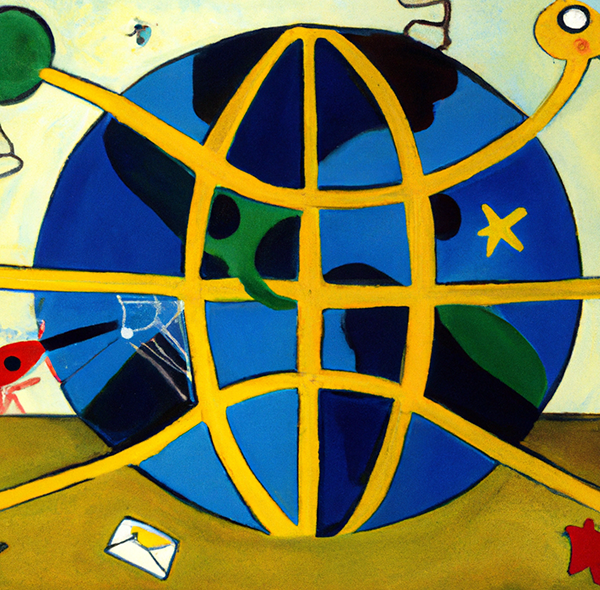
Book Doctors
If you have ever worked in book publishing, you know the term “book doctor” refers to an author (usually uncredited) who “repairs” a manuscript that, for whatever reason, is unpublishable as is and beyond the abilities of the credited author to fix. However, at the Metropolitan Museum of Art in New York, a “book doctor” is someone who repairs the museum’s aging book collection. The New York Times takes us inside the Met’s book conservation lab.
Fearsome machines are part of daily life at the lab, which serves as a hospital where ailing books from every department of the museum are restored to health. The lab’s six employees process an astonishing 2,500 books each year.
Those books arrive daily and are assessed for treatment by the conservation staff. As with any object made of organic materials, books degrade over time. Bindings break, pages tear and crumble, adhesive materials cease to adhere. Decay can be hastened by pests, mold, moisture, heat, cold and plain old use, among countless other factors. Some of the books are rare and valuable. Others are ordinary — say, a book from European Paintings that was dropped on the floor and suffered a broken spine.
The Met has had an in-house book repair facility for nearly a hundred years, but the current conservation lab wasn’t established until 2011. The tools, however, are virtually same as they would have had a century ago:

And of course, the fearsome guillotine cutter familiar to many a commercial printer (or French king):

“For people who love books, entering the lab is like getting hit with Cupid’s arrow,” Dubansky said. “People walk through this door with a dazed expression on their face, wanting to dedicate their entire lives to making sure the books are OK.”
They also have advice for preserving one’s own home book collections.
Light, dust and extreme fluctuations in temperature should be avoided. (“Basements and attics are not your friends.”) Don’t allow books to lean like the Tower of Pisa. Instead, store them in a vertical or horizontal position. Consider applying a Mylar dust jacket cover to books that warrant special protection. And as satisfying as it might be to “crack open” a book, do not actually crack open a book unless you’re aiming to cause spinal injury.
And don’t move heavy boxes of books yourself unless you’re aiming to cause spinal injury of another kind.
Setting on Principle
Type. It’s fundamental to virtually everything we do in graphic communications. But how well do we reallyunderstand typography? A new book aims to deepen our understanding of typography on virtually every level. Universal Principles of Typography by Elliot Jay Stocks contains 100 “principles” of type—from the tactical to the compositional, and even the philosophical. Via Print magazine, from the foreword:
“Typographic knowledge is an awkward mix of science (how people read), technology (what fonts can do), superstition (what folks believe on faith), hard-and-fast-rules (what editors and publishers have codified over time), and unspoken body language (how designers wiggle and fidget inside the rules, inventing new styles and mannerisms). Elliot explores all these forms of knowledge with pictures and words, helping designers navigate the facts and the fictions, and build their own typographic confidence.”
Print spoke to Stocks:
Of all the principles of typography, what is your favorite, the one that you can’t unsee, the one that brings you joy when you see it in action?
There’s a chapter very early on in the book called “Avoid faux (or synthesised) styles” and that might be one of my favourites, purely because the web (and, to a lesser extent, print) is littered with faux italics and the like. As it says in the book, “sure, a faux italic never killed anyone, but it will certainly make you or your client look like you don’t care about doing things properly — and that’s rarely a message clients want to send.” I feel like that could be applied to typography as a whole: these things might seem pedantic at times, but cutting corners is ultimately going to have a negative impact on the end result.
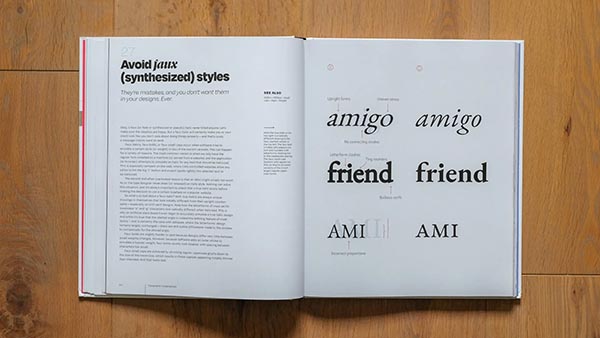
Signs of the Times, Part the Occasional: Another Roadside Attraction
As we have said many times, here and elsewhere, we often take signage for granted, but at their best, signs can evoke certain emotions or memories. Over at Atlas Obscura, they round up 11 signs from around the country that evoke “pure Americana.”
Any road trip across the United States will yield copious amounts of wonder in the form of roadside attractions, many of which stand as pristine examples of Americana. Many of the marquees and signs have been catching the eyes of passersby for decades, a testament to the resilience of steel and a little bit of kitsch. Others dazzle as neon showcases that illuminate an evening cityscape.
There is the nightmarish Topsy the Clown from Reno:

Diamond Jim’s Liquor Store in Anchorage:

And the Star Noodle Dragon in Ogden, Utah:
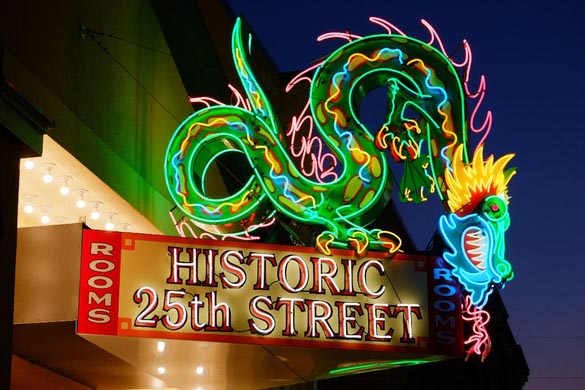
And more.
It’s a testament to the power of signs that many, if not most, of these iconic Americana signs long outlasted the establishments for which they were built.
Out on the Tiles
A board game that has changed little in more than 75 years is Scrabble, the classic word game. However, Mattel has just released a variation of classic Scrabble that puts the emphasis on teamwork to conquer specific challenges rather than come up with obscure two-letter words. Called Scrabble Together, it was released in Europe earlier this week. (While Mattel owns the European rights to the game, Hasbro, which owns the US rights, has no plans to introduce the new version here.) Says the New York Times:
The idea behind Together mode was to make the game more interactive and inclusive, said Ray Adler, vice president and global head of games at Mattel. Research conducted by the company revealed that competition was not as important to younger players as having a way to connect with others and have fun. The new version prioritizes teamwork in order to adapt to those changing values.
Teams win when they complete 20 challenges, aided by “helper cards.” However, if players have expended all the helper cards and are not able to complete a challenge, they have to concede.
Because the Internet exists, there was the predictable grumbling from Scrabble purists, but it’s not like it’s replacing the original.
Mr. Adler made it clear in an interview with The New York Times that the classic version was not going anywhere. “We’re not changing original Scrabble,” he said. “This is just an additive to it that if you don’t like it, you know, don’t play it. We just hope it will bring more people into the game.”

Tenderness on the Blockbuster
Remember Blockbuster Video? For a while in the pre-streaming age, it was the go-to destination for movies and TV shows first on VHS and then on DVD. First Netflix’s DVD-by-mail service and then streaming consigned the chain to extinction. Or should that be near extinction, as, per Boing Boing, there is actually one left—in Bend, Ore. Say what you want about the convenience of streaming, but the writer of a linked Washington Post story on the last physical media holdout understands that part of the appeal is simple nostalgia:
My family used to go to Blockbuster every Friday. Walking to the store on 19th Street and First Avenue in Manhattan, we'd wander through the aisles of DVDs, negotiating what to rent for our weekly ritual of making pizzas and watching movies, and I'd try to sweet-talk my way into a Nerds Rope or a box of watermelon Sour Patch Kids.
But Boing Boing adds that there is more to it than that:
And this really got me thinking about what’s been lost. What we’ve gained in convenience has come at really high cost — the ability to watch anything at any time has crushed the inherent specialness of movies and TV shows.
Back to Bend, Ore. Adds the WaPo:
Sandi Harding, the general manager of the Bend Blockbuster, has been working there since 2004. She watched the franchise’s decline from the front lines, giving countless interviews and figuring out how to keep the store stocked and relevant.
Since there’s no corporate supplier left, Harding buys candy and snacks in bulk from Costco and has figured out how to print and laminate new membership cards. Most of the DVD vendors that they have worked with have closed over the years, and the ones that are still open have minimum orders that are far too big for her store.
“I can’t afford to purchase movies through them, so I’m back to buying 100 percent of everything at Walmart and Target,” Harding told me.
The staff’s DIY efforts pay off: Harding estimates that they still get 500 to 1,000 customers over the course of a weekend.
“It’s all tourism driven now, where before it was all rental driven,” Harding said. “So it’s totally a different experience.”
Hit and Run
There was much handwringing over the March inflation report, with some consternation that our inflation woes are still not over. But if you dig into what prices are actually up, you find that it is mostly housing and gas, the latter likely because, with the advent of spring, more people are on the roads. Speaking of which, another item that is contributing to the high-ish CPI numbers is car insurance, premiums for which seem to have gone through the roof (or at least here in the AtW bunker, despite the fact that we have never filed a claim). Vox explains why car insurance is being driven higher:
This week’s Consumer Price Index (CPI) report — the government’s method for tracking what people are paying for goods and services and how that’s changing over time — noted that the price of car insurance is up more than 22 percent over the same time last year, the largest jump since 1976.
Part of it is that, since the pandemic, everyone seems to be driving like a lunatic:
“Since Covid, we saw this incredible increase in distracted driving,” says Ryan McMahon, senior vice president of strategy for Cambridge Mobile Telematics. “You could almost track it by the day schools started to shut down.”
He’s not just speculating: CMT has access to driver data for millions of drivers, who download apps via their insurance companies that measure things like speeding, hard braking, and cellphone use while driving. McMahon told me that the huge jump they saw in distracted behaviors during the pandemic hasn’t come down since.
At the same time, it’s getting more expensive to repair cars:
Think of a car made in 2004 versus a car made in 2024. If the two crashed, the car from 2024 would probably be more expensive to fix because it’s more likely to have advanced technology like backup cameras and lane sensors.
According to one report by industry analysts CCC, the average estimate for a front-end claim in 2022 was $3,706, up more than 15 percent over the year before. Vehicles more than seven years old, meanwhile, were over $1,000 less to repair.
But, it may be getting better:
“You had this problem where the insurance companies fell behind, so the prices didn’t match the costs and they were losing a bunch of money,” another insider told me. Rates rose in an attempt by insurance companies to catch up with costs, but now inflation isn’t growing at the same runaway clip and insurers aren’t seeing the same levels of loss.
Uh huh. Although it would be great if there were non-driving options in many places.
Conducting Graphene
Was it a good week for graphene news? It’s always a good week for graphene news! Electrons in double-layer graphene move like particles without any mass (we’re jealous). From (who else?) Graphene-Info:
Researchers from the University of Göttingen, Japan’s National Institute for Materials Science and Massachusetts Institute of Technology (MIT) have demonstrated experimentally that electrons in naturally occurring double-layer graphene move like particles without any mass, in the same way that light travels. Furthermore, they have shown that the current can be “switched” on and off, which has potential for developing tiny, energy-efficient transistors.
The so-called “wonder material,” graphene is known, among many other things, for its extremely high conductivity, which is ideal for creating energy-efficient transistors. But:
The challenge has been that to make a transistor, the material needs to be controlled to have a highly insulating state in addition to its highly conductive state. In graphene, however, such a “switch” in the speed of the carrier cannot be easily achieved. In fact, graphene usually has no insulating state, which has limited graphene’s potential a transistor.
Until now.
The research team have now found that two graphene layers, as found in the naturally occurring form of double-layer graphene, combine the best of both worlds: a structure that supports the amazingly fast motion of electrons moving like light as if they had no mass, in addition to an insulating state.
Hairshirts
To create textiles, there really are only two basic sources: plants (and mushrooms) and petroleum products (polyesters). But, via Core77, an idea for a sustainable raw material for textiles that we have more than a surfeit of: human hair. A startup called Human Material Loop is combing through the research.
“Every day, hundreds of tonnes of hair clippings are thrown out,” the company writes, on a section of their website addressing hair salon owners. “All the while, the textile industry is in dire need of a more sustainable, repurposed textile source. We have a solution for both – transforming your hair waste into textile fibers. Because ultimately, your hair clippings are just raw material in the wrong place.”
They add:
“Human hair…possesses incredible durability and strength (one ponytail could hold two elephants).
Don’t try that at home.
Like wool or alpaca, it’s composed largely of keratin protein fibers, making it natural, thermal, biodegradable and moisture-regulating, sans the cruelty or allergic reactions.”
So they have been gathering hair from salons in Europe and turning it into knits that are said to be hypoallergenic, heat-retentive, and antibacterial. They also claim to have produced a sweater, a “tweed-like blazer,” and a parka insulated with human hair.

Says Rain Noe:
It’s a fascinating idea, assuming it works. And while they say they can dye the textiles they create, they don’t mention from what specific source color of hair; I wonder if they can turn black hair into different colors. China and India have 3 billion people between them, and the continent of Africa another 1.2 billion; those populations have predominantly black hair and add up to more than half the planet’s population. The hair textures of those populations are also distinct from that of the Low Countries from which the company has been sourcing their trial hair.
The dyeing issue is an important one—what kinds of chemicals would they need to use? And if dark hair has to be bleached to make it receptive to other colors, is that a good idea? On the plus side, garments made from human hair probably wouldn’t need to be dry-cleaned, just shampooed.
Boringtones
Tired of smartphones? Overwhelmed by apps, email Slack alerts, and the assumption by a certain airline’s app that just because you booked one flight you never want to not be in the air? Well, via The Verge, it may be time for the Boring Phone. A collaboration between HMD and, of all people, Heineken, it’s a simple flip phone with no apps or any of the festoonery of today’s smartphones.
The Boring Phone is apparently real — I know, I was skeptical, too — but it will only be available through giveaways and isn’t going on sale. It’s a limited edition run and Heineken’s website indicates 5,000 will be made. There’s a 2.8-inch QVGA display on the inside, a 1.77-inch display on the outside, a 0.3-megapixel camera, and a 3.5mm headphone jack. It supports calling and texting via 2G, 3G, and 4G, but good luck finding a functioning 3G network anywhere in the US.

It's admittedly more of a publicity/marketing stunt than a true communication medium, but we’re fine with that.
The Boring Phone will be available through social media giveaways in the UK, with other markets to follow later in the year. And if you don’t happen to win one, you’ll be able to download an app that “turns smartphones boring” starting in June. Sign up on Heineken’s website to stay on top of all things Boring Phone.
Head ’Em Off at the Hive!
A common trope of the movie and TV westerns of yesteryear was rustling. No, not digging into potato chip bags or walking through dry leaves, but stealing or indiscriminately killing cattle, horses, and/or other large mammals—which was, by all accounts, a very real problem in the American West. Today’s West faces a new kind of “rustling” that would make for an interesting John Wayne movie: bee theft. Says NOEMA:
Every year, the bloom of thousands of almond trees in California spurs one of the world’s largest, albeit artificial, migrations of animals; as billions of honeybees are loaded onto trucks and sent to deliver lucrative pollination fees for their human keepers. This insect odyssey ensures paydays for often struggling beekeepers, the production of most of the world’s almonds, and increasingly, an opportunity for enterprising thieves.
In a part that would have been perfect for John Wayne, Rowdy Freeman is a deputy at the Butte County Sheriff’s Office in California’s Central Valley, and is the first line of defense against the bee bandits (pilgrim). He is a beekeeper himself, and also keeps statistics on hive thefts.
Last year, according to Freeman calculations, a record of more than 2,300 honeybee hives were stolen in the Central Valley. This year’s thefts could easily surpass that number, with Freeman recording nearly 2,000 hives stolen already. Despite the growing scale of this crime, Freeman is typically the only law enforcement officer working with beekeepers to track the stolen hives and their thieves.
And one could easily imagine a bee-centric remake of Red River:
For some time at the start of each year, the Central Valley becomes a sort of giant, mechanized jamboree of honeybees, with 18-wheelers and semis bearing several million hives traversing this monoculture and depositing their cargo in orchards to propagate the crop. We are accustomed to aggregating sheep and cows and, to a lesser degree at home, our cats and dogs. But in terms of the sheer numbers — 2.7 million hives, according to Wenger, or a lowball estimate of some 54 billion bees to support this year’s almond crop — there is little to compare to the annual seething mass of bees clustered in California outside of enthralling wild scenes like the African migration of wildebeest.
“It makes you think you’re reading an old western about moving 7,000 head of cattle across the high plains,” said Jacob Wenger, an entomologist at California State University, Fresno. “But even then, it wasn’t 90% of all the beef cattle in the United States.”
Would Wenger be the Montgomery Clift character?
Lately, the talk in beekeeping circles has been about whether the surging thefts are the work of the typical solo opportunists wanting to supplement a bad year, or a larger and more organized effort. The theft of hundreds of hives in one go, like in Steinbrugger’s case, pointed to the latter. Such an efficient heist points to a level of organization that only a criminal group, or gang, could pull off.
Now we’re getting into Godfather territory. But changes afoot could upend the pollinator market, for both legitimate beekeepers and nefarious bee thieves.
Some farmers have eyed the dip in the global almond price, plus concerns over prolonged drought and new state rules over groundwater use that could make it harder to grow this thirsty nut, and started thinking about the next cash crop; perhaps pistachios, since they are pollinated via the wind. That would leave less work for the bees, and possibly decrease the amount of beehive theft. But until a more drastic change, the crimes continue to rise.
It’s nuts.
Fork it Over
The new series of the great British panel quiz show Q.I. just premiered (the “U” series), much to our delight here in the Bunker. In the episode “Unsavoury,” there was an item on a special piece of cutlery that Lord Horatio Nelson had fashioned for him. In 1797, he lost an arm at the Battle of Santa Cruz de Tenerife, so to make eating more convenient, he had a special item fashioned. Called variously “Nelson’s Fork” or a “Knork,” it was a combination knife and fork that could be operated with one hand.
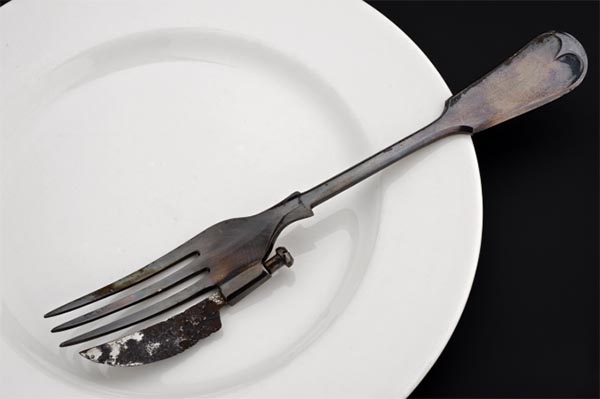
Via The Cutlery Review, the “Knork” caught on in some circles and apparently even Oprah Winfrey is a fan.
There are all sorts of interminglings of the basic trinity of knife, fork, and spoon, of which the spork is perhaps the most famous (and is much older than you think):
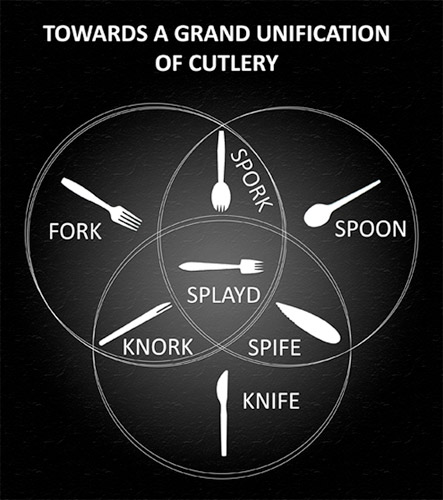
Collect the set!
Pretty In Pink
And the weird food industry collaborations continue. In this case, Heinz has teamed up with Mattel to celebrate Barbie’s 65th anniversary. Says Food & Wine:
Mattel and Heinz UK announced the kind of unconventional collaboration that just made our heads turn: Heinz Classic Barbiecue Sauce. And no, that’s not a typo; we really did mean to say Barbiecue.
It is apparently a mix of vegan mayonnaise and barbecue sauce—and is of course Barbie pink thanks to the addition of beetroot extract.

You know what’s coming:
Heinz UK teased the sauce in an Instagram post in August of last year — alongside a bottle of the only thing that could possibly be paired with it: You guessed it, Tomato Kenchup.
For some reason, perhaps due to international armament agreements, it is not available in the US.
If you want to try the “smoky sauce of the season” Heinz is selling the first 5,000 bottles on its website starting today. The sauce will first be available exclusively in the UK and Spain; however, Heinz says it could potentially expand the offering to other markets in the future.
Don’t threaten us!
This Week in Printing, Publishing, and Media History
April 15
1452: Italian painter, sculptor, and architect Leonardo da Vinci born.
1755: Samuel Johnson’s A Dictionary of the English Language is published in London.
1888: English poet and critic Matthew Arnold dies (b. 1822).
1924: Rand McNally publishes its first road atlas.
1980: French philosopher and author, Nobel Prize laureate Jean-Paul Sartre dies (b. 1905).
April 16
1844: French journalist, novelist, and poet, Nobel Prize laureate Anatole France born.
1871: Irish author, poet, and playwright John Millington Synge born.
1889: English actor, director, producer, screenwriter, and composer Charlie Chaplin born.
1947: Scottish singer-songwriter Gerry Rafferty born.
1994: American novelist and critic Ralph Ellison dies (b. 1913).
2012: The Pulitzer Prize winners were announced, it was the first time since 1977 that no book won the Fiction Prize.
April 17
1397: Geoffrey Chaucer tells The Canterbury Tales for the first time at the court of Richard II. Chaucer scholars have also identified this date (in 1387) as the start of the book’s pilgrimage to Canterbury.
1524: Giovanni da Verrazzano reaches New York harbor. (“If only there were a bridge here,” he is thought have remarked.)
1790: American inventor, publisher, and politician, 6th President of Pennsylvania, Benjamin Franklin dies (b. 1706).
1897: American novelist and playwright Thornton Wilder born.
1955: English singer-songwriter and guitarist Pete Shelley born.
1957: English novelist, essayist, lyricist, and screenwriter Nick Hornby born.
2014: Colombian journalist and author, Nobel Prize laureate Gabriel García Márquez dies (b. 1927).
April 18
1918: American publisher, creator of CliffsNotes Clifton Hillegass born.
1930: The British Broadcasting Corporation announced that “there is no news” in their evening report.
2020: Europe surpasses 100,000 COVID-19 deaths.
April 19
1824: English-Scottish poet and playwright Lord Byron dies (b. 1788).
1927: Mae West is sentenced to 10 days in jail for obscenity for her play Sex.
1971: Launch of Salyut 1, the first space station.
1987: The Simpsons first appear as a series of shorts on The Tracey Ullman Show.
2013: American journalist, author, and publisher, founder of USA Today, Al Neuharth dies (b. 1924).
April 20
1535: The sun dog phenomenon observed over Stockholm and depicted in the famous painting Vädersolstavlan.

1893: Spanish painter and sculptor Joan Miró born.
1912: Anglo-Irish novelist and critic, creator of Count Dracula, Bram Stoker dies (b. 1847).
April 21
753 BC: Romulus founds Rome (traditional date), but not in a day.
1816: Cornish-English novelist and poet Charlotte Brontë born.
1838: Scottish-American environmentalist and author John Muir born.
1910: American novelist, humorist, and critic Mark Twain dies (b. 1835).
1934: The “Surgeon's Photograph,” the most famous photo allegedly showing the Loch Ness Monster, is published in the Daily Mail. (In 1999, it was revealed to have been a hoax.)

1977: Annie opens on Broadway.










Discussion
Join the discussion Sign In or Become a Member, doing so is simple and free